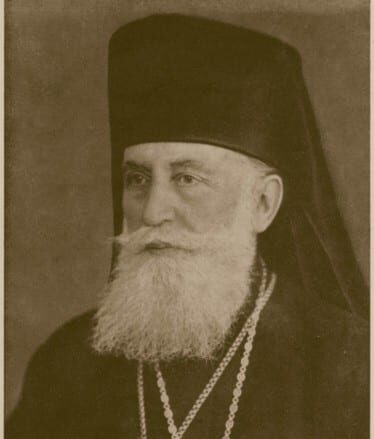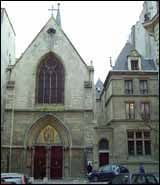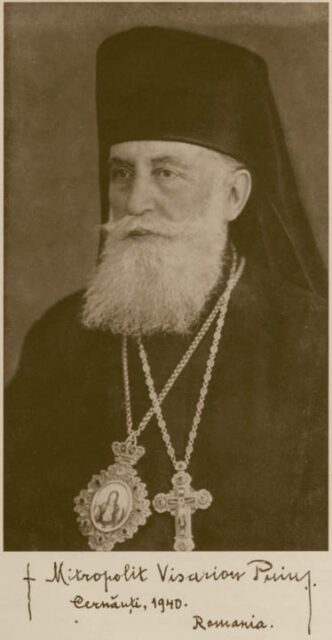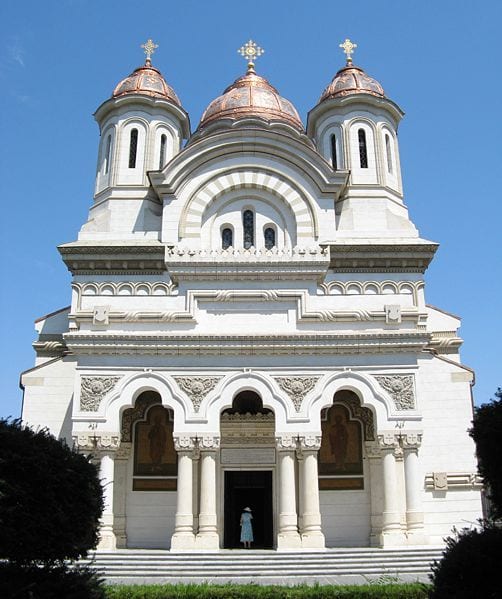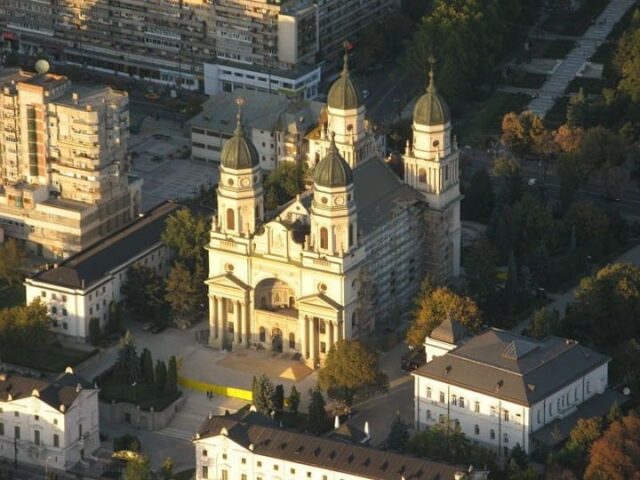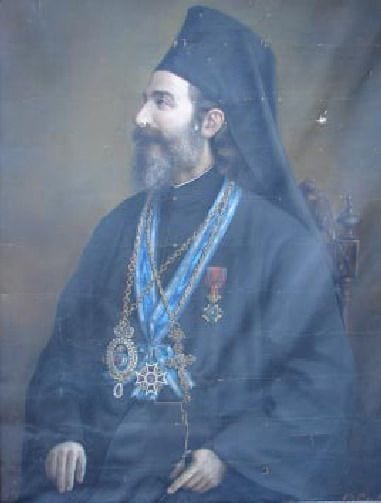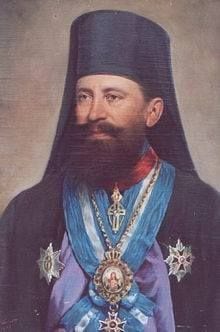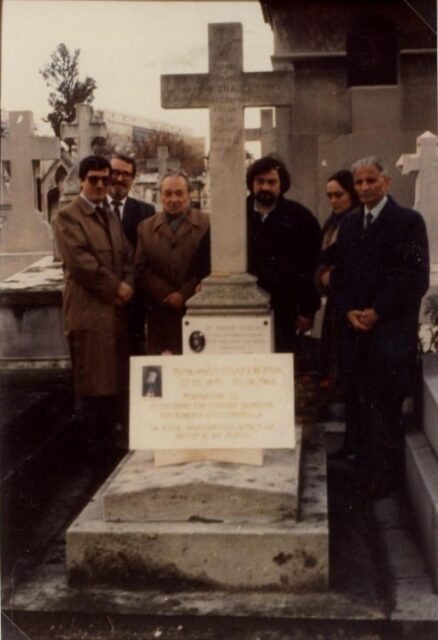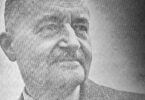‘Remember Your Instructors’ is a precept rarely adhered to in these times. An exception to this rarity seems to be that of Metropolitan Visarion (Puiu), possibly one of the more remarkable Orthodox Hierarchs of the 20th Century. Metropolitan Visarion is both remembered and revered in his homeland, Romania. Next year (2010) a nearly six foot tall bust of Metropolitan Visarion is to be installed in his birthplace, Pascani, Romania. The sculptor, Constantin Crenganis completed the bust and was paid by the Pascani Municipal Council, which raised the cost of the sculpture through donations it solicited. The placing of the bust will commemorate 130 years since the birth, and 45 years since the death of Metropolitan Visarion.
In 2009 a Symposium on Metropolitan Visarion was held in his hometown, and at the nearby renowned Neamt Monastery. The papers read at the Symposium give an indication of the breadth and depth of the interest in the life and works of Metropolitan Visarion:
- ‘Metropolitan Visarion (Puiu): Opposing the Political and Religious Systems between Wars’
Professor Vasile Stance - ‘Controversy in the Historiography of Metropolitan Visarion (Puiu)’
Adrian Nicolae Petcu - ‘Testimony on the Nemenie Houre of Visarion Puiu’
Vovidenie Mihail Demlike, Archimandrite Monastery Neamt - ‘Metropolitan Visarion (Puiu) and the Monastery at Maguzzano’
Preot. Manuel Oliveira - ‘Metropolitan Visarion (Puiu): Missionary in Transnistria, 1941-1944’
Nicolae Videnia - ‘Metropolitan Visarion (Puiu), Martyr of the People, not a War Criminal’
Elena Istratescu - ‘Portrait of the Soul in Words’
Dr. Ioan Lacatasu - ‘Visarion (Puiu): Metropolitan of Romania Abroad’
Prot. Ilie Sandru - ‘Ecclesiology of the Orthodox Church in the Conception of Metropolitan Visarion (Puiu)’
George Enache - ‘Monuments Founded, Restored, and Sanctified by Metropolitan Visarion (Puiu) in Bessarabia, Transnistria, and Bukovina’
Eugenia Antonescu - ‘Metropolitan Visarion (Puiu): Implications for Universal Culture’
Professor Marioaral Penta - ‘Metropolitan Visarion (Puiu): An Enlightened Hierarch’
Pr. Professor Anton Despinescu - ‘Relations between Metropolitan Visarion (Puiu) and Prof. George Alexianu’
Prof. Serban Alexianu
At the conclusion of the Symposium, a Trisagion for the Repose of the Soul of Metropolitan Visarion (Puiu) was served by the Neamt Monastery Dean, Father Florin Tiscanu.
So, it seems the memory of Metropolitan Visarion is alive and well, and the subject of great interest, in Romania in the 21st Century. Metropolitan Visarion has been described as ‘a man who tells the truth at any cost,’ and ‘a great visionary, and a Bishop concerned with developing the Church.’ In a Romania struggling to overcome the effects of nearly 50 years of a brutal and stultifying communist rule, it is fortunate that the Romanian people and Church have Metropolitan Visarion’s life, experiences, and works to look to. Amazingly enough, in these days of rejection of the old, the past, and especially of religion, it seems that the people of Romania are taking advantage of the teachings of their great Hierarch for guidance.
Metropolitan Visarion, in the world Victor Puiu, was born on 27 Feb 1879 in Pascani (the setting for Mikhail Sadoveanu’s novel, ‘The Place Where Nothing Happened’), Romania, Suceava County, near the famous Neamt Monastery, one of the spiritual jewels of the Romanian Orthodox Church. His birthplace was ‘at the bottom of town,’ near the Pascani Railway Station. He was the first of three children. His father was the Priest John Puiu of Girov-Neamt; his mother was Elena Puiu, the daughter of a merchant of the town of Roman, Neculai Miron. The young Victor attended primary school in Pascani. He studied at the Seminaries of Roman and Iasi, and went on to the Theological Faculty in Bucharest, where he received his licentiate in 1905 (an academic degree called a ‘license,’ which confers the right to teach. Earned with 4-6 years of study, equal to the French maitrige, or Master’s Degree). On 22 Dec 1905 he was tonsured a monk, and three days later he was ordained a hierodeacon at the Romanian Chapel in Paris.
As a deacon, he was assigned to the Cathedral of the Holy Voievods in Roman, and then went on to further his studies at the Kiev Theological Academy from June 1907 to July 1908. Founded by Metropolitan Peter (Mohyla, 1596-1646), the Academy enjoyed an international reputation among the Orthodox Churches, and contributed much to the Russian Church. It counted among its alumni Saint Dimitri of Rostov, Saint Paissy Velichkovsky, Patriarch Constantius I of Constantinople (served as Patriarch from 1830-1834), Saint (Bishop) Raphael (Hawaweeny, 1860-1915, of the North American Diocese of the Russian Church), Patriarch Nikodim (Munteanu, 1864-1948) of Romania, and, of course, many renowned Hierarchs of the Russian Church as well as the Russian Church Abroad. Hierodeacon Visarion attended the Kiev Theological Academy on a scholarship from Bishop Melchisedec (Stefanescu) of Roman, a former rector of the Seminary in Roman that he had attended earlier.
On 06 Dec 1908 he was ordained a priest in the St. Nicholas Cathedral of the Diocese of Galati, by Metropolitan Pimen (Petru Georgescu, 1853-1934) of Moldavia. On 01 Jan 1909, he was elevated to Archimandrite, and served as priest at the Cathedral of Galati 1908-1909. On 1 Apr 1909 he was appointed Director of the Theological Seminary in Galati, and Archimandrite of the Diocesan Seat of the Lower Danube. 01 Sep 1918 appointed head of the Chisinau (Russian, Kishinev) Theological Seminary, and from 01 Nov 1918 he was Exarch of Monasteries in Bessarabia. Also worked in a hospital for wounded soldiers in 1918-1919.
In March 1921, he was elected Bishop of Arges, and was consecrated on 25 Mar 1921 by Metropolitan Miron (Cristea) Primate of Romania (Metropolitan Miron {Elie Cristea, 1868-1939} first Patriarch of Romania, elected by Holy Synod 01 Nov 1925. Also served as Prime Minister of Romania, 1938-1939). The same day he was ‘invested’ (recognized) by King Ferdinand I of Romania (1865-1927). On 27 March, he was installed in the Episcopal Chair of Curtea des Arges.
On 13 Mar 1923 he was appointed Bishop of Hotin, and then on 17 Oct 1935 was elected Archbishop of Cernauti and Metropolitan of Bukovina. Metropolitan Visarion was well known for his construction projects to the benefit of the Romanian Orthodox Church, as well as to improve the life of the people. Following are but a few of the improvements seen to by Metropolitan Visarion in places that he served. Bessarabia: construction of the Cathedral of Balti, the Episcopal Palace, various schools, the printing house, the sanatorium, the central park, the water delivery and energy supply systems, city sewer system, and the development of railway travel in Balti. Cernauti: built the Palace of Culture, canteens for workers, rebuilt Vatra Dornei resort, and canteens for forest workers in rather remote locations. As Metropolitan of Moldavia, he instituted a plan for the financial support of the Holy Places in the care of the Patriarchate of Jerusalem, the Patriarchate of Antioch, and the ‘Church Synod of the Russian diaspora.’ He did this through the encouragement of donations through a series of substantial cultural works.
Romanian monks on Holy Mount Athos, from time to time, were the victims of discrimination and persecution that arose against non-Greek residents. These monks wrote to Metropolitan Visarion to ask for assistance in their plight, asking that he merely ‘show his good will’ to them ‘as in previous times,’ which shows evidence of his support for his fellow Romanians on the Holy Mountain. Despite the beneficence to several of the Monasteries of the Holy Mountain by various Romanian rulers, despots, princes, dukes, and other nobility, the Romanians were at times the smallest and most persecuted of the minorities on Mount Athos.
The imposition of the New Calendar upon the Church of Romania caused much strife, struggle, persecution and even death to those who felt they could not betray the Church Fathers. By now, it is obvious that there was more at stake than simply ‘the Calendar.’ The New Calendar was accepted primarily for political reasons; ‘those that accepted it, with hope for improved dialogue and negotiations with the western denominations’ says it rather succinctly. There was an agenda to the introduction of the New Calendar, an agenda that has been largely fulfilled, even upon those Churches who refused to accept the New Calendar itself. Obviously, there were more ways than the introduction of a Calendar to push the agenda. The Romanian Church used the education of its hierarchs as part of its method of pushing the agenda of those who strived for the acceptance of the New Calendar. In 1864, Prince Alexandru Ioan Cuza held a Church Synod at which he recommended the introduction of the Papal Calendar. Saint Calinic of Cernica was present, and at the suggestion to adopt the New Calendar, walked out, remarking, ‘I will not be reckoned with transgressors!’ Another plan was brought into effect, which had more success. There was enacted a proclamation that all Hierarchs of the Romanian Church would have to be licensed in Theology from foreign institutions. The first Patriarch of Romania, Miron (Cristea), was educated at the Karoli Gaspar Protestant University in Budapest; Metropolitan Pimen (Georgescu) of Moldavia was educated in Paris. This type of education was given to all candidates for the Episcopacy that would possibly rule the most important Dioceses of Romania. Metropolitan Visarion himself was sent to school for a few years in Paris.
The time finally came when the introduction of the New Calendar in the Church of Romania was finally proposed. Metropolitan Miron (Cristea) officially proposed the adoption of the New Calendar in 1924. The only Hierarch of the Romanian Orthodox Church who opposed the change was then Bishop Visarion of Hotin. In 1939, he wrote a letter to Stalin urging him to reflect on the facts that the Church is an institution without borders, and that religious belief cannot be destroyed by persecution. In May of 1940, Metropolitan Visarion returned to a monastery. He later admitted a conflict with King Carol II, after Metropolitan Visarion had accused the King of attempting to plunder the antiquities of Bukovina.
From 16 Nov 1942 to 14 Dec 1943, Metropolitan Visarion served as Metropolitan of Transnistria, with his Cathedral in Odessa. Transnistria had been occupied by the Romanian Army, and the Romanian government sent in a Romanian administration which included the Church. Unlike other areas occupied by Romanians, Metropolitan VIsarion allowed the use of Church Slavonic for Divine Services, and also allowed the use of the Old Calendar. He also opened many churches closed by the Soviets, and helped the poor, the needy, and children. He also tried to educate the people in the Orthodox Faith; as a result, he was very popular, and beloved by the Orthodox people of Transnistria, and not seen as an oppressor and occupier.
In August 1944, Metropolitan Visarion was sent to Zagreb, Croatia by Patriarch Nikodim (Munteanu). He was sent to represent the Romanian Church, and to act as co-consecrator, at the consecration of the first Croatian Bishop for the Croatian Orthodox Church, a creation of the Ustashi government of Croatia in its war against the Serbian Orthodox Church (detailed information concerning the Croatian Orthodox Church will be found in the biography of Archbishop Germogen {Maximov, 1861-1945}, who as Metropolitan of Zagreb headed the Croatian Orthodox Church). The Romania Orthodox Church sent a delegation to this consecration because they were the only Orthodox church to recognize the Croatian Church. The reason for this recognition is that at the time, Romania was ruled by the Fascist regime of Ion Antonescu, which was an ally of Nazi Germany and Ustashi Croatia.
An August, 1944 coup against the Antonescu regime by King Michael I speeded the Soviet advance into Romania. King Michael’s government proclaimed loyalty to the Allies, and accepted an armistice offered by the Unites States, Great Britain, and the U.S.S.R. The Red Army, acting as if Romania was still an enemy, robbed and raped its way through Romania at will. Metropolitan Visarion, on learning the news from Romania, knew that his anti-communism, his service in Transnistria, and his status as an Orthodox Metropolitan would all result in no good coming to him from the Soviet occupiers of Romania. He knew he could not go back, and never returned to Romania for the remainder of his life, living as an exile in Western Europe.
In Zagreb, Metropolitan Visarion, suffering an illness, wished to go to Vienna. He found a pilot in Zagreb who offered to take him. Due to the war situation, he was shortly imprisoned near Salzburg, and was accused of being part of the Fascist Romanian Iron Guard. He was finally released, and went to Italy in 1945, where he was hosted by the Don Calabria Institute Maguzzano, and was assisted by Pope Pius XII and Cardinal Tisserant. He went on to Switzerland, where he was reported to be critically ill in a hospital. He stayed in Switzerland until 1948.
On 21 Feb 1946, a ‘Romanian People’s Tribunal’ (an arm of the Romanian Communist Party and Soviet occupation forces) convicted Metropolitan Visarion of ‘war crimes’ for his activities in Transnistria, and sentenced him to death in absentia.
After leaving Croatia, Metropolitan Visarion communicated with the Romanian Patriarchate about establishing an autonomous Romanian Orthodox Diocese in Western Europe, free from the communist domination that the Patriarchate and Metropolitan Visarion knew was coming to Romania. Patriarch Nikodim (Munteanu) requested that should Metropolitan Visarion indeed begin such a Diocese, he should place it under the jurisdiction of the Russian Orthodox Church Abroad, as Patriarch Nikodim explained, ‘to protect its canonical independence.’
After recovering in Switzerland, Metropolitan Visarion lived in various places in Western Europe: Germany, southern France, Auvergne, until finally settling in the village of Viels Maisons, 96 km east of Paris. In 1948, the Romanian Orthodox Episcopate of Western Europe was organized with a dependent basis on the Synod of the Russian Church Abroad (‘dependenta juridic de Sinodul Ortodox Rus . . . ‘). The headquarters of the new Diocese was in Paris, at the Church of the Holy Archangels.
On 29 Mar 1950, the Grand Synod of the Patriarchate of the Romanian Orthodox Church, under the Chairmanship of Patriarch Justinian (Marina, ) examined the case of Metropolitan Visarion (Puiu). It was noted that Metropolitan Visarion lead a ‘harmful foreign Orthodox group,’ and had furthermore lead a ‘cabal’ against the Romanian Orthodox Church since 1925, when he wrote an article published in the newspaper, ‘Union,’ (organ of the Greek Catholic Church in Romania) in which he stated he ‘respected the Pope and the Catholic Church,’ thereby proving he was an imperialist agent. The Grand Synod further accused Metropolitan Visarion of ‘leaving Romania without permission,’ though when he left he did so to go to Croatia at the behest of the Patriarch, and that he was currently in the service of the Imperialists and the Vatican, attempting to uproot the Romanian Orthodox Church by breaking from the Mother Church. For these ‘facts,’ and taking into account the proposal of Metropolitan Nicolae (Balan), the Grand Synod decided unanimously that: 1. Metropolitan VIsarion (Puiu) is defrocked by the Church. 2. All documents that he issues abroad are void, and the Romanian Orthodox should consider Visarion Puiu a layman who is not Orthodox. Noting the death sentence against Metropolitan Visarion, the Grand Synod condemned him for ‘seditious acts against the Romanian State,’ and branded him a ‘traitor to the interests of the people of Romania.’ Obviously ‘defrocked’ under pressure from the communist government, the decision of the Grand Synod was completely ignored by Metropolitan Visarion and the clergy and members of his Diocese.
The Romanian Cathedral in Montreal, Canada was part of Metropolitan Visarion’s Diocese: ‘By 1951, Metropolitan Visarion Puiu’s secretary in Paris, Dr. Petre Popescu, was elected Parish Priest in Montreal, and he continued being under the canonical coverage of Metropolitan Visarion Puiu and the Romanian Orthodox Episcopate of Western Europe. At the Romanian Patriarch Nicodim’s request, Metropolitan Visarion Puiu had this Episcopate join the Synod of the Russian Orthodox Church Outside Russia (ROCOR) headquartered in New York so as to protect its independence.’
The Western European Episcopate founded by Metropolitan Visarion had a somewhat stormy history. He noted that it was established with much ‘pain’ after the Holy Archangels Parish in Paris had agreed to leave the jurisdiction of the Romanian Patriarchate. Metropolitan Visarion had hoped to embrace all the Romanian communities in Western Europe within his Diocese, but this did not happen. He complained that Romanian exile life was disturbed by many conflicts political in nature, and was marked by misunderstandings, scandal, and anarchy. Some of the clergy were in favor of leaving the jurisdiction of the Russian Church Abroad for that of the Ecumenical Patriarchate, fearing ‘isolation’ in the Church Abroad. The continual conflict affected Metropolitan Visarion negatively, and he wished to have a Vicar Bishop consecrated that would eventually succeed him.
Archimandrite Teofil (Ionescu, 1896-1975) was chosen as Metropolitan Visarion’s Vicar. A graduate of the Bucharest Faculty of Theology (he earned his licentiate in Theology in Bucharest with a paper entitled, ‘Life and Work of Metropolitan Peter Movila of Kiev;’ he earned a Doctorate in Theology from the Protestant Faculty of Theology in Paris with the same paper), Archimandrite Teofil had served as rector of the Holy Archangels Cathedral in Paris from 1939-1945. He served in the United States after 1945.
‘On 13/26 December 1954, with the Blessing of Metropolitan Anastassy (Gribanovsky, 1873-1965) First Hierarch of the Synod of the Russian Orthodox Church Abroad, and based on legal Nr./3/503/1634 of 29 Oct/11 Nov 1954,’ Archimandrite Teofil ‘was ordained Bishop with the title of Severineanul’ (after Sevres, a small town near Paris) by Metropolitan Visarion (Puiu), Saint Archbishop John (Maximovich, 1896-1966) of Brussels and Western Europe, and Bishop Nafanael (Lvov, 1906-1986), Administrator of Russian Parishes in North Africa, in the Russian Synodal Church of Saint Nicholas in Versailles. The ordination of Archimandrite Teofil was kept from the Parish Council of the Holy Archangels Russian Cathedral in Paris, and was known only to the Priest Boldeanu, the Lawyer Jean Miloae, and Metropolitan Visarion’s niece. The St. Nicholas Church where the ordination took place was very small, and not far from the Romanian Cathedral, which was large. Apparently the Priest Boldeanul had kept the arrival of Archimandrite Teofil in Paris from the USA a secret, and also kept the ordination a secret, facts later sorely lamented by Metropolitan Visarion.
After continued disappointemnt, Metropolitan Visarion sent a letter, dated 20 Mar 1958, to the Parish Council of the Holy Archangels Cathedral. He noted that when he created the Romanian Orthodox Diocese of Western Europe, he hoped it would become a refuge, and a chance for the Romanians in the Diaspora to become more spiritual, but that his goal was not supported by anyone; that his hope for the atmosphere of the parish in Paris to be one of peace and cooperation apostolic remained futile; that Bishop Teofil (Ionescu), ordained as a Vicar for the Diocese, had left for the United States, and not performed any function in the Diocese for over three years; that the Parish Council was not composed entirely of persons having the qualities required for a Christian Church; that he could no longer allow the Church to be used as a forum for those interested only in political unrest-it could be used only for the religious needs of the Diocese; he then decided that, effective 01 Apr 1958, the Diocese was to be considered ‘dismantled.’
The reaction of the parish was to announce the cessation of all canonical and administrative relation with Metropolitan Visarion, and to pass under the canonical protection of Bishop Teofil (Ionescu).
Metropolitan Visarion lived out the rest of his life ‘disappointed, poor, and sick;’ his niece never deserted him, and cared for him the remainder of his life. He reposed on 13 Aug 1964. On 14 Aug 1964, his funeral was served by the Mitred Protopriest Emilian Vasiloschi of the Romanian Diocese in Germany, and Priest Nicholas Kovalevsky from the Russian Exarchate of the Patriarchate of Constantinople (‘Paris Jurisdiction’). The funeral was served in the small Roman Catholic Church in the village of Viels Maisons, and he was buried in the local cemetery. On 3 Oct 1964, a memorial service was held for the repose of the soul of Metropolitan Visarion, served by Archbishop George (Tarasov, 1893-1981), Russian Exarch of the Patriarch of Constantinople, and 12 priests from his Cathedral (‘rue Daru’).
After several years, Father Michael Costandache had the remains of Metropolitan Visarion reburied in the Montparnasse Cemetery in Paris. Bishop Teofil (Ionescu) was buried in an adjoining plot.
On 25 Sep 1990, Metropolitan Visarion was ‘rehabilitated’ by the Holy Synod of the Romanian Orthodox Church. The decree of his defrocking was reversed, and attention was turned to his achievements for the Holy Church, and the Church of Romania. And, as noted at the beginning of this biography, a new interest in the life and achievements of Metropolitan Visarion has begun in a new century.
- www.coichirleanca.go.ro
- www.nordlitera.ro
- www.cartesiarte.ro
- www.procesulcomunismuluii.ca
- www.stiri.rol.ro
- www.natioalist.ro
- www.evz.ro
- www.egliseroumaine.com
- www.dmoz.org
- www.razborintrucuvant.ro
- www.ebooks.unibuc.ro
- www.basarabia.info
- www.russned.ru
- www.patriarhia.ro
- www.ortodoxia.de
- www.memoria.ro
- www.romfest.org
- www.mmb.ro
- www.alternativaonline.ca
- www.ziarrullumina.ro
- www.edituratrinitas.ro
- www.cdep.ro
- www.mitropoliaro.de
- www.conororbiri.literare.dntis.ro
- www.protopopuatalromana.ro
- www.reference.com
- www.cuzanet.ro
- www.bunavestire.ro
- www.crestinortodox.ro
- www.cuvalo.net
- www.ceeol.com
- www.scribd.com
- www.dic.academic.ru
- www.lisr.ro
- www.pascani.ro
- www.bucharest.romaniaexplorer.com
- www.orthodoxphotos.com
- www.commons.wikimedia.org
- Speake, Graham Mount Athos: Renewal in Paradise. New Haven and London, 2002

